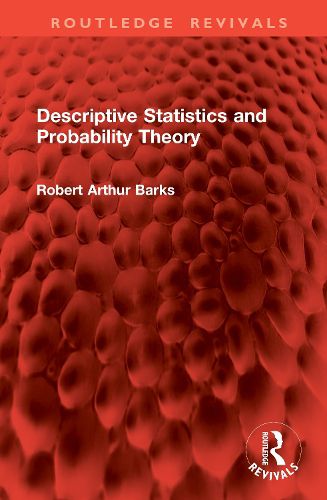Readings Newsletter
Become a Readings Member to make your shopping experience even easier.
Sign in or sign up for free!
You’re not far away from qualifying for FREE standard shipping within Australia
You’ve qualified for FREE standard shipping within Australia
The cart is loading…






First published in 1972, in Descriptive Statistics and Probability Theory the numerical work- the selection of numerical data-is used as a basis for developing the statistical theory. Other starting points could have been chosen but a beginner will readily understand this sort of work and hence be able to 'get the feel of' statistics, untroubled by the learning of fresh concepts.
From this numerical work emerges the 'need' to introduce counting techniques, permutations, combinations and the binomial theorem. In a similar way the necessity for probability is shown and the basic ideas are developed intuitively. A final short chapter shows how these ideas can be formalised within an axiomatic system. In all cases, simple intuitive ideas are taken as a starting point and then discussion leads to the final formalization. As concepts are introduced the language of statistics is developed. A large number of examples is used and they are all worked in full detail. Occasionally the reader is placed in a problem situation and invited to attempt his own individual solution before reading on to match his own attempts to other solutions. It is hoped that motivation of this sort will lead the reader to develop greater sensitivity than would otherwise be the case. This is an important read for students of statistics, mathematics and economics.
$9.00 standard shipping within Australia
FREE standard shipping within Australia for orders over $100.00
Express & International shipping calculated at checkout
First published in 1972, in Descriptive Statistics and Probability Theory the numerical work- the selection of numerical data-is used as a basis for developing the statistical theory. Other starting points could have been chosen but a beginner will readily understand this sort of work and hence be able to 'get the feel of' statistics, untroubled by the learning of fresh concepts.
From this numerical work emerges the 'need' to introduce counting techniques, permutations, combinations and the binomial theorem. In a similar way the necessity for probability is shown and the basic ideas are developed intuitively. A final short chapter shows how these ideas can be formalised within an axiomatic system. In all cases, simple intuitive ideas are taken as a starting point and then discussion leads to the final formalization. As concepts are introduced the language of statistics is developed. A large number of examples is used and they are all worked in full detail. Occasionally the reader is placed in a problem situation and invited to attempt his own individual solution before reading on to match his own attempts to other solutions. It is hoped that motivation of this sort will lead the reader to develop greater sensitivity than would otherwise be the case. This is an important read for students of statistics, mathematics and economics.